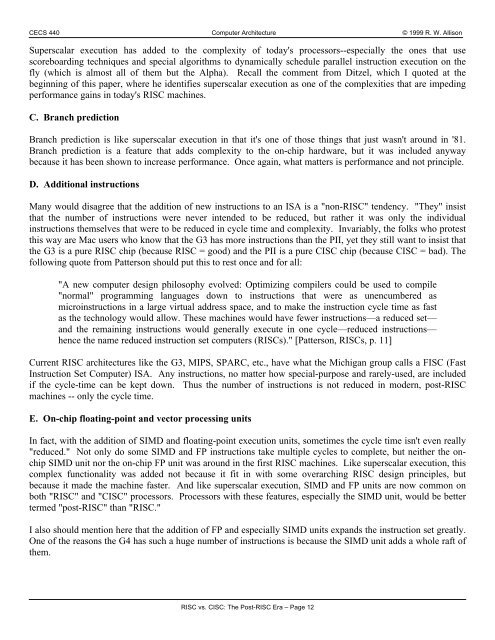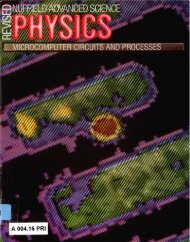RISC vs. CISC
RISC vs. CISC
RISC vs. CISC
Create successful ePaper yourself
Turn your PDF publications into a flip-book with our unique Google optimized e-Paper software.
CECS 440 Computer Architecture © 1999 R. W. Allison<br />
Superscalar execution has added to the complexity of today's processors--especially the ones that use<br />
scoreboarding techniques and special algorithms to dynamically schedule parallel instruction execution on the<br />
fly (which is almost all of them but the Alpha). Recall the comment from Ditzel, which I quoted at the<br />
beginning of this paper, where he identifies superscalar execution as one of the complexities that are impeding<br />
performance gains in today's <strong>RISC</strong> machines.<br />
C. Branch prediction<br />
Branch prediction is like superscalar execution in that it's one of those things that just wasn't around in '81.<br />
Branch prediction is a feature that adds complexity to the on-chip hardware, but it was included anyway<br />
because it has been shown to increase performance. Once again, what matters is performance and not principle.<br />
D. Additional instructions<br />
Many would disagree that the addition of new instructions to an ISA is a "non-<strong>RISC</strong>" tendency. "They" insist<br />
that the number of instructions were never intended to be reduced, but rather it was only the individual<br />
instructions themselves that were to be reduced in cycle time and complexity. Invariably, the folks who protest<br />
this way are Mac users who know that the G3 has more instructions than the PII, yet they still want to insist that<br />
the G3 is a pure <strong>RISC</strong> chip (because <strong>RISC</strong> = good) and the PII is a pure <strong>CISC</strong> chip (because <strong>CISC</strong> = bad). The<br />
following quote from Patterson should put this to rest once and for all:<br />
"A new computer design philosophy evolved: Optimizing compilers could be used to compile<br />
"normal" programming languages down to instructions that were as unencumbered as<br />
microinstructions in a large virtual address space, and to make the instruction cycle time as fast<br />
as the technology would allow. These machines would have fewer instructions—a reduced set—<br />
and the remaining instructions would generally execute in one cycle—reduced instructions—<br />
hence the name reduced instruction set computers (<strong>RISC</strong>s)." [Patterson, <strong>RISC</strong>s, p. 11]<br />
Current <strong>RISC</strong> architectures like the G3, MIPS, SPARC, etc., have what the Michigan group calls a FISC (Fast<br />
Instruction Set Computer) ISA. Any instructions, no matter how special-purpose and rarely-used, are included<br />
if the cycle-time can be kept down. Thus the number of instructions is not reduced in modern, post-<strong>RISC</strong><br />
machines -- only the cycle time.<br />
E. On-chip floating-point and vector processing units<br />
In fact, with the addition of SIMD and floating-point execution units, sometimes the cycle time isn't even really<br />
"reduced." Not only do some SIMD and FP instructions take multiple cycles to complete, but neither the onchip<br />
SIMD unit nor the on-chip FP unit was around in the first <strong>RISC</strong> machines. Like superscalar execution, this<br />
complex functionality was added not because it fit in with some overarching <strong>RISC</strong> design principles, but<br />
because it made the machine faster. And like superscalar execution, SIMD and FP units are now common on<br />
both "<strong>RISC</strong>" and "<strong>CISC</strong>" processors. Processors with these features, especially the SIMD unit, would be better<br />
termed "post-<strong>RISC</strong>" than "<strong>RISC</strong>."<br />
I also should mention here that the addition of FP and especially SIMD units expands the instruction set greatly.<br />
One of the reasons the G4 has such a huge number of instructions is because the SIMD unit adds a whole raft of<br />
them.<br />
<strong>RISC</strong> <strong>vs</strong>. <strong>CISC</strong>: The Post-<strong>RISC</strong> Era – Page 12











